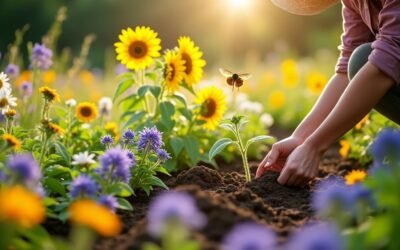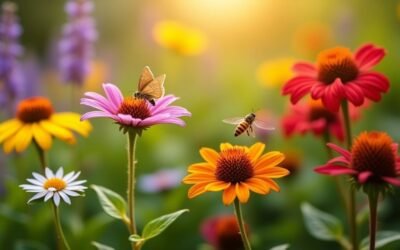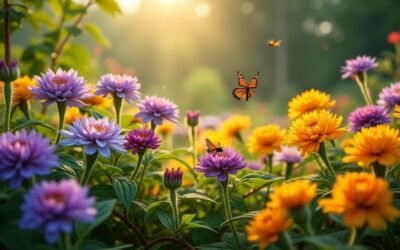Dahlias comprise over 42 wild species and thousands of cultivated hybrids, originating from Mexico and Guatemala's diverse landscapes. They're prized for their remarkable range of colors, from vibrant reds to subtle pastels, and their impressive flower sizes spanning 4 to 10 inches in diameter. The genus, named after botanist Anders Dahl, demonstrates exceptional genetic diversity through its octoploid structure, which enables extensive hybridization possibilities. Modern cultivars showcase various forms, including Double, Cactus, Single, and Collarette varieties, while requiring full sun and well-drained soil for ideal growth. This botanical diversity offers gardeners endless possibilities for creating stunning displays and supporting local pollinators.
Main Points
- Dahlias comprise over 42 species and thousands of cultivars, originating from Mexico and Guatemala as wild species.
- Species Dahlia variabilis demonstrates exceptional genetic diversity through hybridization, leading to numerous modern garden varieties.
- The octoploid genetic structure of dahlias enables extensive hybridization potential, resulting in diverse flower forms and colors.
- Notable hybrid varieties include 'Patricia', 'Apricot Sunrise', and 'Emily', showcasing successful breeding outcomes.
- Modern breeding programs utilize genetic understanding to predict and develop new cultivars with desired traits.
Introduction
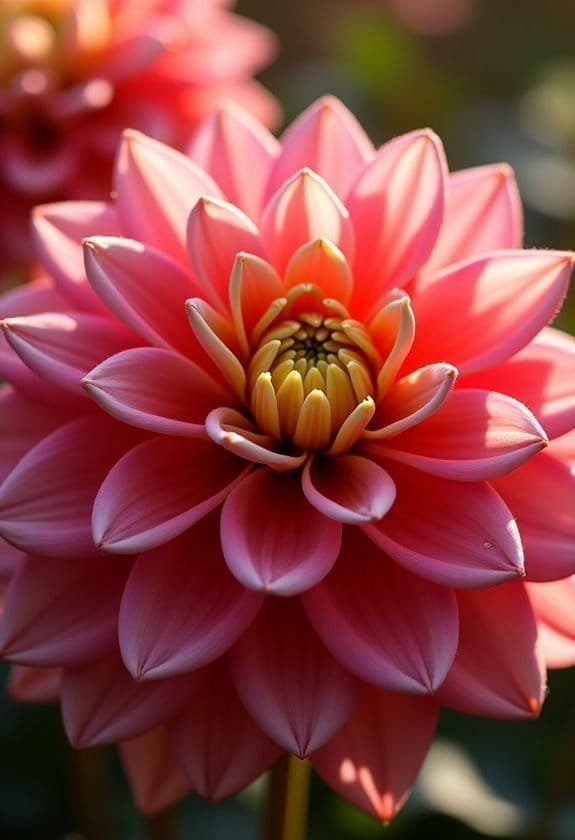
Dahlias (Dahlia spp.), native to Mexico and Guatemala, have evolved from wild species into one of horticulture's most diverse and cherished flowering plants.
These members of the Asteraceae family showcase an extraordinary range of colors, shapes, and sizes, with blooms spanning from intimate two-inch pompons to dramatic dinner-plate varieties reaching twelve inches in diameter.
Through extensive hybridization efforts since their discovery in the 16th century, dahlias now encompass more than 42 species and tens of thousands of cultivars, making them an invaluable asset in both ornamental gardens and scientific research.
Common Name
Widely recognized for their spectacular blooms and remarkable diversity, these beloved garden flowers derive their common name "dahlia" from Anders Dahl, an 18th-century Swedish botanist. His contributions to botanical science earned him this enduring horticultural legacy, which now graces flower gardens worldwide through countless dahlia hybrids and cultivars.
The name has become synonymous with the striking diversity found within the Asteraceae family, representing over 57 species that showcase an impressive array of colors, forms, and sizes. From the elegant Cafe au Lait to the deep purple Thomas Edison variety, these flowering plants have captured the imagination of gardeners and botanists alike.
The common name's widespread adoption has helped establish dahlias as cornerstone specimens in ornamental horticulture.
Throughout their mid-summer to fall blooming period, these plants demonstrate why their namesake's influence persists in modern gardening culture. Whether grown as striking focal points in dedicated beds or cultivated for their excellent cutting qualities, dahlias continue to honor their botanical patriarch while delighting both casual gardeners and serious collectors with their stunning displays.
Scientific Name
Within botanical nomenclature, the scientific classification Dahlia stands as both genus name and tribute to Anders Dahl's legacy in the Asteraceae family. This taxonomic designation, established in the 18th century, places these remarkable flowers alongside their cousins, the sunflowers and daisies, in one of botany's most diverse plant families.
The species Dahlia variabilis represents a fascinating cornerstone of Dahlia hybridization, demonstrating nature's capacity for genetic diversity through open pollination. Its octoploid genetic structure, containing eight chromosomal sets, has enabled breeders to develop an extraordinary range of fully double blooms and unprecedented color variations.
The creation of New Dahlia varieties continues to expand, building upon the rich genetic foundation first documented by Francisco Hernandez in 1570 during his Mexican expeditions. Modern taxonomists have carefully mapped the genus's complex evolutionary relationships, revealing how its unique genetic architecture facilitates the development of distinct cultivars.
This scientific understanding has revolutionized breeding programs, allowing horticulturists to better predict and control trait inheritance while maintaining the flower's celebrated diversity within its formal classification system.
Overview
From their modest origins in Mexico and Guatemala to their current status as horticultural stars, the journey of dahlias represents one of gardening's most remarkable success stories.
These fascinating plants, named after botanist Anders Dahl, have evolved from simple wildflowers to complex hybrid masterpieces through centuries of careful breeding.
The genetic complexity of dahlias, featuring eight sets of chromosomes, has enabled breeders to develop thousands of distinctive cultivars. This extraordinary genetic diversity manifests in an astounding array of flower forms, from elegant single blooms to intricate cactus-type varieties that captivate gardeners worldwide.
Today's dahlia hybrids showcase an impressive spectrum of colors, sizes, and shapes that would have been unimaginable to their early cultivators. The American Dahlia Society now recognizes numerous classifications based on flower characteristics, reflecting the plant's remarkable adaptability to selective breeding.
While their ancestors were initially grown for their edible tubers, modern dahlias have been transformed into ornamental showstoppers that grace gardens from summer through fall. Their evolution from food crop to flowering phenomenon demonstrates nature's incredible potential when guided by human ingenuity.
Key Features
Dahlias exhibit remarkable diversity in their growth patterns, with heights ranging from compact 12-inch border plants to towering 6-foot specimens that command attention in garden displays.
Their distinctive blooms showcase an extraordinary spectrum of colors, shapes, and sizes, from the elegant 4-inch pompons to spectacular 10-inch dinner plate varieties.
These versatile plants typically grace gardens with continuous flowering from mid-summer through the first frost, producing an abundance of blooms that peak during the late summer months when many other perennials have finished their display.
Growth Size
Understanding the growth size of dahlias is essential for successful garden planning. The Royal Horticultural Society recognizes that these versatile plants exhibit remarkable variation in their mature heights, with different types ranging from compact varieties to towering specimens.
Most dahlia species reach heights between 18 and 60 inches, making them adaptable to various garden settings and design schemes. The first true consideration for gardeners should be the specific variety's expected size, as exemplified by the Mystic Illusion Dahlia, which maintains a moderate height of 18 to 36 inches.
When planning dahlia beds, proper spacing of 9 to 12 inches between plants promotes ideal growth and prevents overcrowding, allowing each specimen to develop its full potential.
The plants' impressive blooms, spanning 4 to 10 inches in diameter, complement their vertical growth patterns and create stunning visual displays.
To achieve these maximum dimensions, dahlias require strategic placement in full sunlight, with a minimum of 6 hours daily exposure. This careful attention to spacing and sun exposure guarantees that these ornamental plants can reach their full growth potential while maintaining healthy development throughout the growing season.
Appearance
Beyond their impressive stature in the garden, the visual appeal of dahlias stems from their extraordinary range of colors and forms. These spectacular blooms showcase an impressive palette, from delicate salmon and coral hues to pristine whites, sunny yellows, dramatic reds, and ethereal lavenders.
Their dimensional presence extends far enough to command attention in any landscape design, with flower heads spanning an impressive 4 to 10 inches in diameter.
The structural complexity of dahlia blooms presents a fascinating botanical arrangement, featuring both ray and disk flowers working in harmonious partnership. While the showy ray flowers create the outer display, the central disk flowers contain crucial reproductive elements essential for pollination.
Gardeners can choose from several distinct flower classifications, including the densely packed Double, the spiky Cactus, the simple elegance of Single, and the decorative Collarette varieties.
The visual impact doesn't stop at the flowers themselves, as many cultivars boast striking foliage in deep, rich tones that provide a dramatic backdrop for their vibrant blooms, creating a complete ornamental package.
Flowering Season
Throughout the growing season, a dahlia planting rewards gardeners with an extended bloom period that stretches from mid-summer until the first frost arrives in fall. The flowering patterns of these remarkable plants follow a predictable timeline, with blooms emerging just 3-5 days after germination and continuing for 75-90 days.
Each dahlia specimen demonstrates impressive productivity, generating approximately 35 blooms per plant in various forms including double, semidouble, and single varieties. The spectacular bloom colors range from delicate pastels to vibrant jewel tones, while their impressive size spans 4 to 10 inches in diameter, creating striking focal points in garden designs.
Seasonal care during the flowering period supports not only the plant's health but also its role in the broader ecosystem. The extended blooming season makes dahlias particularly important for supporting local pollinators, as bees and butterflies frequent these flowers throughout their lengthy display period.
This sustained flowering characteristic, combined with their abundant bloom production, guarantees that dahlias maintain their visual impact and ecological significance well into the autumn months.
Growing Requirements
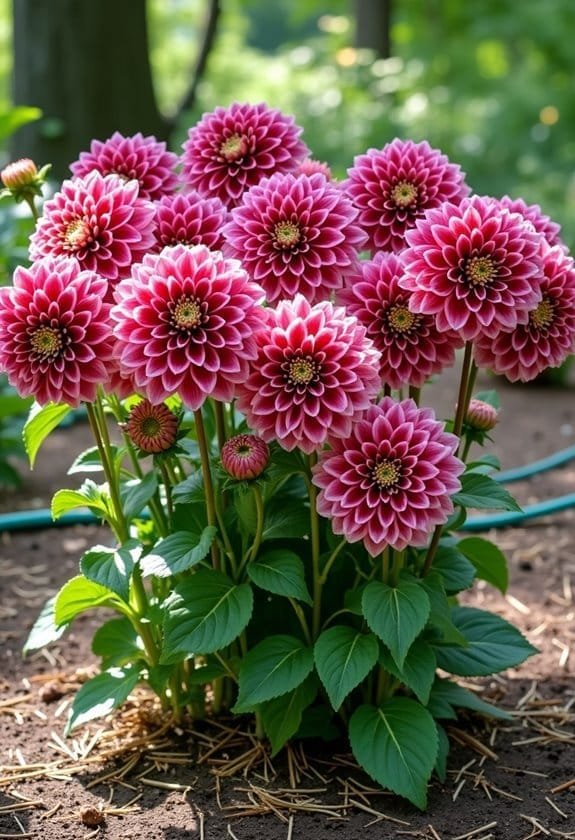
Successful dahlia cultivation hinges on meeting several essential environmental conditions, including full sun exposure of at least 6 hours daily and well-drained, nutrient-rich soil with a pH between 6.0 and 7.0.
The plants flourish in moderate temperatures between 65-70°F (18-21°C), requiring consistent moisture levels through regular watering practices, particularly during periods of drought.
To guarantee peak growth and abundant blooming, gardeners should space their dahlias 9-12 inches apart, allowing proper air circulation while maintaining a consistent fertilization schedule every 4-6 weeks with a balanced nutrient formula.
Light
Dahlias depend on bright, direct sunlight for their spectacular flowering display. These remarkable plants require a minimum of six hours of daily sun exposure to achieve their full potential, with sunlight effects directly influencing both growth patterns and bloom quality.
Light management plays an essential role in cultivating healthy dahlias, as proper exposure promotes robust stems, abundant flowers, and enhanced color saturation.
While dahlias can adapt to partial sun conditions, receiving between four to six hours of daily light, this reduction may compromise their flowering vigor and overall performance. Inadequate light exposure often manifests in telling ways, causing plants to develop elongated, weak stems and produce fewer, less vibrant blooms.
Shadow considerations become particularly important when positioning dahlias in the garden, as nearby trees, buildings, or tall companion plants can inadvertently create light barriers that impact their growth.
Experienced gardeners carefully evaluate potential planting locations, taking into account seasonal sun patterns and surrounding vegetation to guarantee their dahlias receive ideal illumination throughout the growing season, thereby maximizing their ornamental appeal and reducing susceptibility to common garden ailments.
Soil
To achieve ideal growth and flowering, these stunning plants require well-drained, nutrient-rich soil with a pH between 6.0 and 7.0. Soil types that support ideal dahlia growth include loamy mixtures that strike a balance between moisture retention and drainage capacity, allowing roots to develop efficiently while preventing waterlogged conditions.
Successful dahlia cultivation often depends on thoughtful soil amendments, with organic matter playing a vital role in creating the ideal growing environment. Incorporating well-rotted compost or aged manure into the existing soil enhances both fertility and structure, providing essential nutrients while improving drainage solutions.
Gardeners should guarantee their soil maintains consistent moisture levels without becoming saturated, as standing water can lead to root decay and fungal infections.
Regular soil testing serves as a valuable tool for monitoring and maintaining ideal growing conditions. When test results indicate the need for adjustments, gardeners can implement targeted amendments to maintain the ideal pH range and nutrient balance.
Creating raised beds or adding organic materials like peat moss and perlite can help improve drainage in areas with naturally heavy or clay-rich soils.
Water
Proper water management plays an essential role in dahlia cultivation, requiring consistent moisture levels without oversaturation. Effective watering techniques guarantee these flowering plants maintain their vibrant blooms while preventing potential root diseases that can emerge from waterlogged conditions. Regular irrigation frequency, particularly during dry spells, helps sustain the plant's robust growth and flowering potential.
Moisture management becomes especially critical during the germination phase, when seedlings require temperatures between 65-70°F (18-21°C) and consistently moist soil for prime development. Like a well-orchestrated balance, the soil should maintain adequate moisture without becoming saturated, allowing roots to breathe while accessing necessary hydration.
Experienced gardeners often implement strategic mulching practices around dahlia plants, which serves as a natural moisture-retention system while simultaneously suppressing unwanted weed growth.
To achieve prime results, gardeners should monitor soil drainage carefully and adjust their irrigation practices accordingly. This careful attention to moisture levels, combined with proper drainage solutions, helps prevent root rot and other moisture-related issues that could compromise the plant's health and flowering capacity.
Temperature
Beyond proper moisture levels, understanding temperature requirements plays an essential role in successful dahlia cultivation. These striking flowers exhibit peak growth and flowering when temperature effects remain within the sweet spot of 65°F to 75°F (18°C to 24°C) during their active growing season.
Effective temperature management begins at planting time, when soil temperatures must consistently stay above 60°F (15°C) to guarantee successful seed germination and early development.
While dahlias appreciate the warmth of full sun exposure for at least six hours daily, they're particularly sensitive to temperature fluctuations at the lower end of the spectrum. When temperatures drop below 32°F (0°C), frost can severely damage or kill these tender plants, making protective measures vital during early spring plantings.
The relationship between temperature and moisture becomes especially significant during warm spells, as dahlias require consistent watering to maintain their vigor in elevated temperatures.
Gardeners must carefully balance these environmental factors, providing adequate warmth while guaranteeing proper drainage, as excessive heat combined with waterlogged soil can stress these temperature-sensitive beauties.
Pollinator Criteria
Dahlias' intricate flower structure, with accessible ray and disk flowers, creates an ideal landing platform for essential pollinators like bees and butterflies.
The plants' genetic makeup produces an extraordinary spectrum of colors and shapes, which acts as a powerful beacon for pollinating insects throughout the growing season.
These pollinator-friendly characteristics reach peak effectiveness when dahlias are planted in substantial groupings, allowing insects to move efficiently between blooms while promoting successful cross-pollination and genetic diversity.
Attracted Pollinators
These stunning garden flowers serve as natural magnets for essential pollinators, particularly bees and butterflies drawn to their vibrant colors and accessible blooms.
The structural configuration of dahlias, featuring both ray and disk flowers, creates ideal landing platforms that accommodate various pollinator preferences. Their diverse color palette, ranging from bold reds to subtle pastels, greatly influences flower color influence on visitor frequency.
During the critical mid-summer to fall period, dahlias maintain consistent nectar production, supporting garden biodiversity through sustained pollinator activity.
Research has demonstrated that larger dahlia varieties, especially those with open-centered blooms, receive more frequent visits from beneficial insects.
The flowers' architecture acts like a well-designed restaurant, offering convenient access to nutritious rewards for different pollinator species.
Pollination Method
A successful pollination process in dahlias depends on the intricate relationship between flower structure and pollinator behavior. The flower's distinctive architecture, featuring both ray and disk flowers, creates an ideal environment for insect interactions, particularly with bees and butterflies that serve as primary pollinators. The specialized disk flowers contain essential reproductive components that facilitate effective cross-pollination through their strategic placement and design.
The pollination techniques in dahlias have evolved to maximize reproductive success through several sophisticated adaptations. Hair-like projections on the stigma enhance pollen capture efficiency, while the flower's structure guides pollinators toward reproductive elements during their foraging activities.
These natural mechanisms work in concert with environmental conditions to guarantee successful fertilization and subsequent seed production. The process of open pollination, where pollen transfer occurs between different dahlia plants, contributes notably to genetic diversity in hybrid populations.
Weather patterns and pollinator availability play critical roles in determining pollination success rates, as these external factors directly influence the movement and behavior of insect pollinators throughout the growing season.
Care & Maintenance
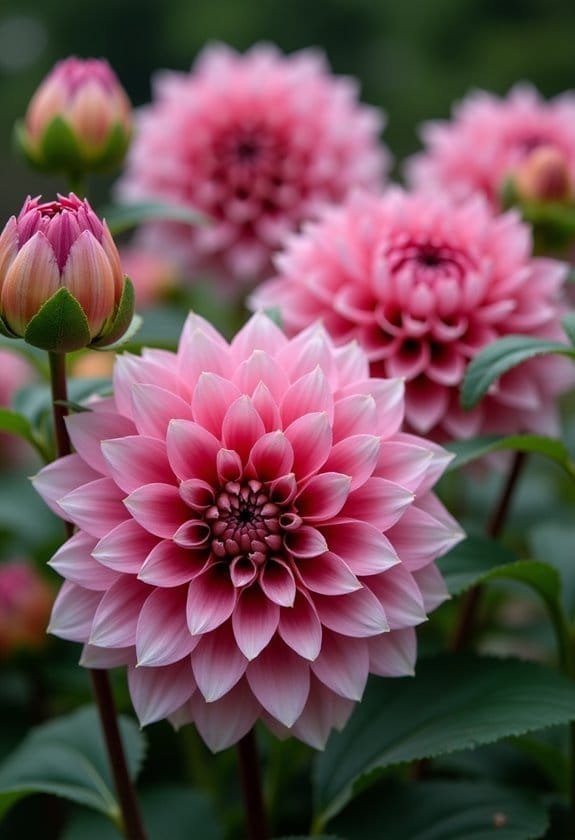
Dahlias thrive with consistent, thorough care that focuses on three essential aspects: proper planting, regular maintenance, and thoughtful companion selection.
Successful planting begins with well-drained soil enriched with organic matter, while ongoing care demands regular deadheading, fertilization every 4-6 weeks, and vigilant pest monitoring throughout the growing season.
These stunning flowers harmonize particularly well with salvias, cosmos, and zinnias, which not only complement their dramatic blooms but also attract beneficial pollinators to the garden space.
Planting Tips
Successful dahlia cultivation begins with proper timing and ideal growing conditions. For optimal variety selection and growth potential, gardeners should initiate planting 4-5 weeks before their region's final frost date, guaranteeing the soil temperature maintains a consistent range of 65-70°F for successful germination.
When implementing planting techniques, it's vital to prepare well-draining soil with a pH between 6.0 and 7.0, creating an environment that supports robust root development and nutrient uptake.
Seasonal maintenance becomes more manageable when dahlias are positioned in locations that accommodate their eventual height and spread, particularly for taller varieties that'll require staking as they mature.
The soil's fertility plays a significant role in the plant's development, necessitating regular fertilization every 4-6 weeks with a balanced nutrient formula to sustain vigorous growth throughout the blooming season.
Gardeners should establish a consistent watering schedule, paying particular attention during dry spells, while incorporating deadheading practices into their routine maintenance.
This thorough approach to planting guarantees that dahlias achieve their full potential, rewarding growers with abundant, vibrant blooms throughout the growing season.
Ongoing Care
Throughout the growing season, proper dahlia maintenance demands consistent attention to several key care requirements. Seasonal adjustments in fertilization schedules, utilizing a balanced nutrient formula every 4-6 weeks, guarantee robust growth and spectacular blooming cycles, while companion planting with pest-deterrent species can enhance natural protection against common invaders like aphids.
Regular pruning techniques, particularly deadheading spent blooms, act as the cornerstone of successful dahlia cultivation, promoting continuous flowering and preventing energy waste on seed production.
Gardeners must remain vigilant about structural support, implementing sturdy stakes for taller varieties that serve as botanical scaffolding against gravity's persistent pull. The strategic placement of plants to maximize air circulation serves as a natural defense mechanism against fungal pathogens, particularly the persistent threat of powdery mildew.
This careful orchestration of spacing not only promotes plant health but also creates an aesthetically pleasing garden display. Successful dahlia care requires a harmonious balance of these maintenance practices, transforming ordinary garden plots into vibrant showcases of horticultural expertise through systematic monitoring and timely interventions.
Suggested Companions
In carefully planned gardens, strategic companion planting enhances both the health and aesthetics of dahlia displays. The thoughtful integration of complementary species creates a balanced ecosystem that supports robust dahlia growth while maximizing visual appeal throughout the growing season.
Zinnias and cosmos serve as excellent companion plants, attracting essential pollinators that benefit the entire garden space while creating a harmonious color palette alongside dahlia blooms.
Marigolds play a dual role as both pest deterrents and decorative additions, naturally repelling harmful insects like aphids and nematodes through their distinctive aromatic compounds.
For structural diversity, ornamental grasses provide an architectural element that contrasts beautifully with dahlia's bold blooms, creating depth and visual interest in the garden design.
Herbs, particularly basil, offer additional protection against unwanted pests while contributing practical value to the garden space.
When selecting companion plants, it's important to choose species that share dahlias' requirements for full sun exposure and consistent moisture levels, ensuring all plants thrive together in their shared environment.
Common Issues
Dahlias face several challenging adversaries, from microscopic pests like aphids and spider mites to persistent fungal infections such as powdery mildew, which can greatly compromise plant health.
While these issues can appear intimidating, most problems respond well to early detection and targeted interventions, including introducing beneficial insects and maintaining proper air circulation.
Regular monitoring combined with preventive measures, such as appropriate spacing between plants and careful moisture management, creates a strong defense against the most common dahlia afflictions.
Pests/Diseases
Managing common pests and diseases presents ongoing challenges for dahlia growers. Effective pest prevention strategies often begin with vigilant monitoring for aphids, spider mites, and slugs, which can swiftly compromise plant health if left unchecked.
These unwanted visitors primarily target the foliage, leading to stunted growth and diminished bloom production.
Disease management techniques focus heavily on preventing fungal infections, with powdery mildew being a particularly persistent threat in humid conditions. Implementing organic control methods, such as maintaining proper plant spacing of 9-12 inches, proves essential for promoting adequate air circulation and reducing disease spread.
Regular deadheading serves a dual purpose by encouraging continuous blooming while minimizing the presence of decaying material that could harbor pathogens.
Careful attention to watering practices remains fundamental to both pest and disease control. While overwatering creates favorable conditions for root rot development, insufficient moisture weakens plants' natural defenses against invaders.
Successful dahlia cultivation requires striking a delicate balance between providing adequate moisture and maintaining ideal growing conditions that discourage both pest infestations and disease outbreaks.
Solutions
Three main solutions address the most common dahlia growing challenges.
First, implementing effective dahlia propagation methods includes regular deadheading, which redirects the plant's energy from seed production to continuous blooming, ensuring a vibrant display throughout the growing season.
Strategic pest management strategies involve early detection and prompt treatment of common invaders like aphids and spider mites, often through integrated approaches combining biological controls with careful monitoring.
Seasonal care tips focus on maintaining ideal growing conditions through proper cultural practices. Establishing a consistent watering schedule becomes essential during dry spells, while ensuring adequate drainage prevents root problems that could compromise plant health.
For taller varieties, installing support structures early in the growing season prevents stem damage and maintains the aesthetic appeal of blooming plants. Additionally, proper spacing between plants promotes essential air circulation, considerably reducing the risk of fungal diseases such as powdery mildew.
When combined with regular maintenance practices, these solutions create an environment where dahlias can thrive and produce their characteristic stunning blooms throughout the season.
Summary
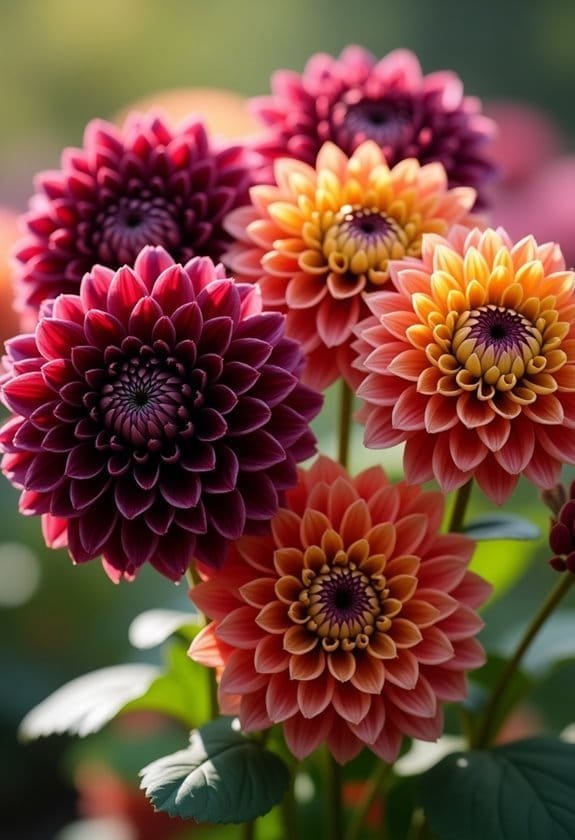
Throughout horticultural history, we've witnessed the remarkable evolution of dahlia species and hybrids into one of gardening's most diverse flowering plants. The fascinating journey of dahlia hybridization techniques began with simple double forms and has expanded into thousands of cultivars, showcasing an extraordinary range of color variations that captivate gardeners worldwide.
The octoploid genetic structure of dahlias has enabled hybridizers to create an impressive array of forms, from the elegant Cactus types to the striking Collarette varieties. Notable achievements in breeding have produced celebrated hybrids like 'Patricia', 'Apricot Sunrise', and 'Emily', each contributing unique characteristics to the dahlia palette.
The American Dahlia Society's systematic approach to classification and evaluation has provided essential guidance for both novice and experienced hybridizers.
These stunning plants, which produce blooms ranging from 4 to 10 inches in diameter, have proven themselves adaptable to various growing conditions, though they thrive best in full sun and well-drained soil.
Their reliable mid-summer to fall flowering period has secured their position as indispensable elements in modern gardens.
